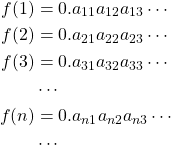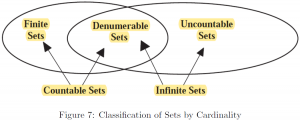15 Cardinality
Let us recall our path so far. First, we studied sets and the set theory. Then, we related elements within the set itself, as well as across multiple sets. Then, we advanced our thoughts on relations to functions. However, we have been missing a concept of crucial importance so far – cardinality. In plain terms, cardinality refers to the number of elements of a given set. That being said, we might as well wonder, for example, should it not be the case the number of elements has to be the same for a bijection, and also for an inverse function, to be defined?
Let us begin with the definition of the equivalence of sets.
Finite Sets
Definition.
The sets ![]() and
and ![]() are equivalent, denoted
are equivalent, denoted
![]()
if there exists a bijection from ![]() to
to ![]() .
.
Naturally, it follows that
Theorem.
The equivalence of sets is an equivalence relation.
Viewing the cardinality as the number of elements in a given set, it is intuitive the equivalence of sets is indeed an equivalence relation. Let us formally define cardinality.
Definition. (Finite and Infinite Sets)
Let ![]() for
for ![]() . Then, a set
. Then, a set ![]() is
is
* finite, if ![]() or there exists
or there exists ![]() such that
such that ![]()
* infinite, otherwise.
Definition. (Cardinality)
The cardinality or the cardinal number of a finite set ![]() is defined as the number
is defined as the number ![]() such that
such that
![]() and denoted
and denoted ![]()
In case ![]() , then
, then ![]() .
.
A useful theorem that overlaps with the set theory is introduced as follows:
Theorem.
For finite sets ![]() and
and ![]() ,
, ![]() is finite and
is finite and
![]()
Here we introduce another theorem known as the Pigeonhole Principle. In colloquial terms, suppose there are ![]() pigeon holes, while there are
pigeon holes, while there are ![]() pigeons. If the number of holes and pigeons are not the same, then naturally there would be extra, either holes or pigeons. Formally,
pigeons. If the number of holes and pigeons are not the same, then naturally there would be extra, either holes or pigeons. Formally,
Theorem. (The Pigeonhole Principle)
For ![]() , where
, where ![]() ,
,
If ![]() , then
, then ![]() is not bijective.
is not bijective.
Proof.
Our proof utilizes the principles of mathematical induction (PMI), with the proof by contradiction. Since ![]() , we begin with
, we begin with ![]() setting the statement of pigeon hole principle as
setting the statement of pigeon hole principle as ![]() .
.
1. (Basis Step)
When ![]() , then
, then ![]() , for
, for ![]() .
.
Therefore, ![]() is not bijective.
is not bijective.
2. (Inductive Step)
Suppose the pigeonhole principle is true for ![]() .
.
Then, there is no bijection ![]() .
.
Now, let us suppose the negation of ![]() , i.e. there exists a bijection
, i.e. there exists a bijection ![]() where
where ![]() .
.
Then,
![]()
This is contradiction, since ![]() .
.
Therefore, it must be the case our supposition is false, i.e. there does not exist a bijection ![]() where
where ![]() .
.
3. Therefore, we conclude ![]() is true for all
is true for all ![]() by the principles of mathematical induction.
by the principles of mathematical induction.
In fact, the pigeonhole principle is simply another way of stating the non-equivalence of sets.
Infinite Sets
Now we delve into infinite sets. Recall the definition of infinite sets in the earlier section that there does not exist a non-empty set ![]() such that
such that ![]() for
for ![]() . In other words, there does not exist a constant to express the number of elements of such set
. In other words, there does not exist a constant to express the number of elements of such set ![]() . Then, we can view infinitely many number of elements as an increasing state. In fact, there are two kinds of infinitely many numbers – one is countably many, or denumerable, and the other is uncountably many. First, we introduce the definition of denumerability.
. Then, we can view infinitely many number of elements as an increasing state. In fact, there are two kinds of infinitely many numbers – one is countably many, or denumerable, and the other is uncountably many. First, we introduce the definition of denumerability.
Definition.
A denumerable set ![]() is defined as
is defined as
![]()
with ![]()
Let us explore the cardinality ![]() with an example.
with an example.
Example. Prove the set ![]() is denumerable.
is denumerable.
Proof.
Let ![]() and define
and define ![]() by
by ![]() .
.
Suppose ![]() .
.
Then, ![]() .
.
Then, ![]() .
.
Therefore, ![]() is injective.
is injective.
Let ![]() .
.
Choose ![]() , so that
, so that ![]() .
.
Then, ![]() .
.
Then, ![]() .
.
Then, ![]() .
.
Therefore, ![]() is surjective.
is surjective.
Therefore, ![]() is bijective.
is bijective.
Then, there exists a bijection ![]() .
.
Therefore, ![]() , and thus
, and thus ![]() .
.
Now, let us introduce a bigger infinite number, continuum ![]() , well demonstrated by the famous Cantor’s Diagonal Argument.
, well demonstrated by the famous Cantor’s Diagonal Argument.
Definition.
An uncountable cardinal number ![]() , continuum, is defined as
, continuum, is defined as
![]()
Theorem. (Cantor’s Diagonal Argument)
Let ![]() .
.
Note that
![]()
Therefore, ![]() .
.
Suppose ![]() .
.
Then, there exists a bijection ![]() .
.
Let us list the images of ![]() in normalized form:
in normalized form:

Now, let us define ![]() , where
, where
![]()
Then, ![]() .
.
However, ![]() for all
for all ![]() , since
, since ![]() differs from
differs from ![]() in the
in the ![]() -th decimal place.
-th decimal place.
Therefore, ![]() .
.
This is a contradiction, and thus ![]() .
.
Then, ![]() , since
, since ![]() .
.
Thinking of the cardinal number ![]() , in fact, every open interval is a continuum, summarized as:
, in fact, every open interval is a continuum, summarized as:
Theorem.
![]() for all
for all ![]() .
.
Let us illustrate with an example.
Example. Continuity of Real Numbers
Prove ![]() .
.
Let us define a mapping ![]() by
by ![]() .\\
.\\
Then, on ![]() , this is a fractional linear transformation of one branch of the tangent function (Figure 1), and bijective to
, this is a fractional linear transformation of one branch of the tangent function (Figure 1), and bijective to ![]() .\\
.\\
Therefore, ![]() .
.
Thus, the sets by cardinality can be summarized as follows [14]:

